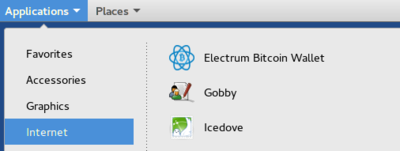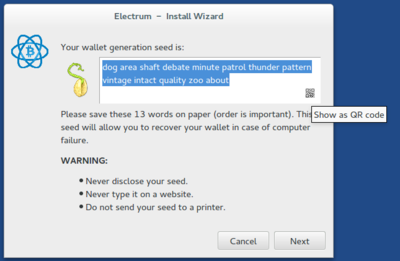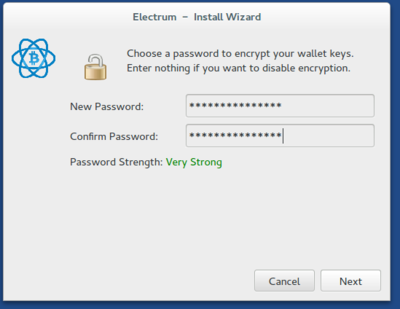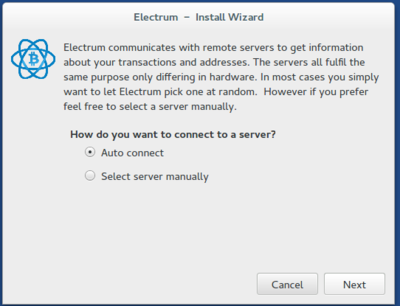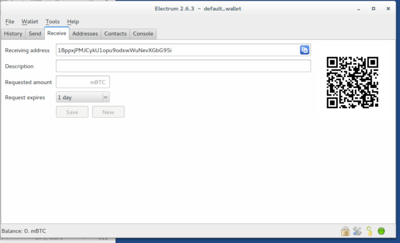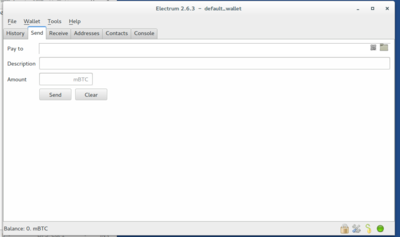Difference between revisions of "Cryptocurrency (Buying things anonymously)"
From Gender and Tech Resources
(→Introducción Criptomonedas) |
|||
| (6 intermediate revisions by 2 users not shown) | |||
| Line 3: | Line 3: | ||
==Introduction== | ==Introduction== | ||
| − | A | + | A cryptocurrency is a type of currency that is stored electronically and incorporates encryption for security of transactions. Cryptocurrency can be used, like conventional currencies, to buy products or pay for services. Intuitively, we can think of cryptocurrencies as digital coins, however, because of the technology they incorporate and the way they work they are not the same. |
| − | There is no | + | There is no single universally accepted definition for cryptocurrencies, but Wikipedia states: |
| − | + | "A cryptocurrency (or crypto currency) is a digital asset designed to work as a medium of exchange using cryptography to secure the transactions and to control the creation of additional units of the currency. Cryptocurrencies are a subset of alternative currencies, or specifically of digital currencies. Bitcoin became the first decentralized cryptocurrency in 2009. Since then, numerous cryptocurrencies have been created. These are frequently called altcoins, as a blend of bitcoin alternative. Bitcoin and its derivatives use decentralized control as opposed to centralized electronic money/centralized banking systems. The decentralized control is related to the use of bitcoin's blockchain transaction database in the role of a distributed ledger <ref>https://en.wikipedia.org/wiki/Cryptocurrency</ref>" | |
| − | + | There are many different types of cryptocurrencies, but all of them have a value determined by supply and demand and are impossible, in principle at least, to falsify (even though this does not prevent all fraud, see for example the case of OneCoin<ref>https://steemit.com/money/@morpheustitania/onecoin-is-a-scam</ref>). | |
| − | + | Broadly speaking, we can trace the birth of cryptocurrencies to the criptopunk movement that advocated the use of cryptography as a tactic for social change. One of the first electronic coins was Digicash, launched in 1990 by David Chaum. This centrally-operated currency already incorporated encryption and allowed electronic transactions<ref>https://en.wikipedia.org/wiki/DigiCash</ref>. | |
| − | + | Seven years later Adam Black proposed Hashcash, a mining system that used a proof-of-work algorithm (POW <ref>https://en.wikipedia.org/wiki/Proof-of-work_system</ref>) to limit spam (unwanted mail) and denial of service (DoS) attacks, and would later be incorporated into other cyptocurrencies. In 2009 an unknown individual using the pseudonym Satoshi Nakamoto published Bitcoin, one of the most used cryptocurrencies and the main focus of this ''How to' guide'. | |
| − | + | Bitcoin is characterised by <ref>http://chimera.labs.oreilly.com/books/1234000001802/ch01.html#_what_is_bitcoin</ref>: | |
| − | + | -> A decentralized p2p network (the bitcoin protocol) | |
| − | -> | + | -> Public transactions (the block chain) |
| − | -> | + | -> A decentralized "deterministic" coin and mathematical production (distributed mining) |
| − | -> | + | -> A decentralized transaction verification system (transaction script) |
| − | + | Currently it has the following fundamental principles <ref>https://en.wikipedia.org/wiki/Blockchain_%28database%29</ref>: | |
| − | + | -> Absolute limit on currency production: the number of units will never exceed 21 million bitcoins. | |
| − | -> | + | -> It is uncensored: no one can ban or censor valid transactions. |
| − | -> | + | -> It is open source: Bitcoin's source code should always be accessible to everyone. |
| − | -> | + | -> No permission is required: nobody can prevent participation in the network. |
| − | -> | + | -> It is anonymous : no identification is required to participate in the Bitcoin network. |
| − | -> | + | ->It is fungible: each unit is interchangeable. |
| − | -> | + | -> Payments are irreversible: Confirmed transactions can not be modified or reversed. The story is unforgettable. |
| − | + | You can watch the following video to see how a mining farm of bitcoins looks like in China | |
| + | {{#ev:vimeo|https://vimeo.com/141600878}} | ||
| − | + | == What do you need?== | |
| − | + | A TAILS USB with persistence | |
| − | == | + | == How can I use bitcoins to buy anonymously?== |
| − | + | To be able to make transactions with Bitcoin you need to have an address (with which you can receive or send Bitcoins) and keys, with which your transactions will be signed. This set of keys is known as a Wallet. | |
| + | [[File:Wallet_bitcoin.png|400px|thumb|left|Wallets <ref>https://bitcoin.org/en/choose-your-wallet</ref>]] | ||
| − | + | Bitcoin currently has a large number of wallets that can work as programs, mobile applications and even as devices. | |
| − | + | Although Bitcoin incorporates encryption in order to achieve anonymity in purchases, it requires that transactions can not be associated with your legal identity. This is not so simple, you can see more information at: https://en.bitcoin.it/wiki/Anonymity. For this guide we will use the wallet that comes in TAILS by default: Electrum <ref>https://electrum.org/#home</ref>. | |
| − | + | ||
| − | + | === Five steps to create a wallet in TAILS=== | |
| − | + | 1) In Applications go to Internet and open Electrum Wallet Bitcoin | |
| − | + | ||
| − | + | ||
| − | + | ||
| − | + | ||
| − | + | ||
| − | + | ||
| − | + | ||
| − | 1) | + | |
[[File:electrum1.png|400px|thumb|center|Electrum]] | [[File:electrum1.png|400px|thumb|center|Electrum]] | ||
| − | 2) | + | 2) Follow the process by selecting the option to create a new wallet standard |
[[File:electrum2.png|400px|thumb|center|Creando tu cuenta.]] | [[File:electrum2.png|400px|thumb|center|Creando tu cuenta.]] | ||
| − | 3) | + | 3) The wallet creation program generates 13 words and suggests you copy them on paper or use a QRT code. You can choose the one you prefer but for the QRT code you will also need a program that reads this type of code. |
[[File:electrum3.png|400px|thumb|center|]] | [[File:electrum3.png|400px|thumb|center|]] | ||
| − | 4) | + | 4) You will be prompted for a password (use a strong one and do not forget it) |
[[File:electrum4.png|400px|thumb|center|]] | [[File:electrum4.png|400px|thumb|center|]] | ||
| − | 5) | + | 5) The program will ask you if it connects itself or if you prefer to do it manually, you can select the option that better suits you. |
[[File:electrum5.png|400px|thumb|center|]] | [[File:electrum5.png|400px|thumb|center|]] | ||
| − | 6) | + | 6) Your wallet has been created. You now have an address to 'receive' deposits and you can make transactions with others by sending them Bitcoins if you know their shipping addresses. |
| − | [[File:electrum6.png|400px|thumb|left| | + | [[File:electrum6.png|400px|thumb|left|Adress to receive Bitcoins]] |
| − | [[File:electrum7.png|400px|thumb|none| | + | [[File:electrum7.png|400px|thumb|none|Sending Bitcoins]] |
| − | + | ||
| − | + | ||
| − | + | ||
| − | + | ||
| − | + | ||
| − | + | ||
| − | + | ||
| − | + | ||
| − | + | ||
| − | + | ||
| − | + | ||
| − | + | ||
| − | + | ||
| − | + | ||
| + | ===Adding Bitcoins to your wallet=== | ||
| + | There are different ways to to receive bitcoins in your wallet. To buy Bitcoins anonymously you need to find an intermediary organization that trades bitcoins and that will accept an anonymous bank ATM deposit (you'll need to find a bank that offers this service -eg <ref> https://www.bitboat.net/en/help</ ref>). Once you have made your deposit the intermediary organization will transfer the bitcoins to your wallet. Another way is through an intermediary organization that offers instant deposits like MoneyPolo<ref>https://moneypolo.com</ref> . | ||
| − | === | + | ===Buying=== |
| − | + | As in other types of electronic transactions, to buy something, you need to find services that accept bitcoins, for example sellers of domains, electronic products, services, medicines, and then you need to know where to send the bitcoins, i.e. a shipping address: https://en.wikipedia.org/wiki/OpenBazaar. | |
| − | + | ===Final notes=== | |
| + | Remember that all transactions are public so, to avoid addresses being associated with purchases, you can make deposits of small quantities of bitcoins and transfer equally small amounts. | ||
| − | + | You should also remember that ATMs have cameras and that effective facial recognition is increasingly widely used. | |
| + | Finally, there are countries where it is illegal to use Bitcoins <ref>https://en.wikipedia.org/wiki/Legality_of_bitcoin_by_country</ref> . | ||
| − | == | + | ==References== |
Latest revision as of 09:22, 20 March 2017
Contents
Introduction
A cryptocurrency is a type of currency that is stored electronically and incorporates encryption for security of transactions. Cryptocurrency can be used, like conventional currencies, to buy products or pay for services. Intuitively, we can think of cryptocurrencies as digital coins, however, because of the technology they incorporate and the way they work they are not the same.
There is no single universally accepted definition for cryptocurrencies, but Wikipedia states:
"A cryptocurrency (or crypto currency) is a digital asset designed to work as a medium of exchange using cryptography to secure the transactions and to control the creation of additional units of the currency. Cryptocurrencies are a subset of alternative currencies, or specifically of digital currencies. Bitcoin became the first decentralized cryptocurrency in 2009. Since then, numerous cryptocurrencies have been created. These are frequently called altcoins, as a blend of bitcoin alternative. Bitcoin and its derivatives use decentralized control as opposed to centralized electronic money/centralized banking systems. The decentralized control is related to the use of bitcoin's blockchain transaction database in the role of a distributed ledger [2]"
There are many different types of cryptocurrencies, but all of them have a value determined by supply and demand and are impossible, in principle at least, to falsify (even though this does not prevent all fraud, see for example the case of OneCoin[3]).
Broadly speaking, we can trace the birth of cryptocurrencies to the criptopunk movement that advocated the use of cryptography as a tactic for social change. One of the first electronic coins was Digicash, launched in 1990 by David Chaum. This centrally-operated currency already incorporated encryption and allowed electronic transactions[4].
Seven years later Adam Black proposed Hashcash, a mining system that used a proof-of-work algorithm (POW [5]) to limit spam (unwanted mail) and denial of service (DoS) attacks, and would later be incorporated into other cyptocurrencies. In 2009 an unknown individual using the pseudonym Satoshi Nakamoto published Bitcoin, one of the most used cryptocurrencies and the main focus of this How to' guide'.
Bitcoin is characterised by [6]:
-> A decentralized p2p network (the bitcoin protocol)
-> Public transactions (the block chain)
-> A decentralized "deterministic" coin and mathematical production (distributed mining)
-> A decentralized transaction verification system (transaction script)
Currently it has the following fundamental principles [7]:
-> Absolute limit on currency production: the number of units will never exceed 21 million bitcoins.
-> It is uncensored: no one can ban or censor valid transactions.
-> It is open source: Bitcoin's source code should always be accessible to everyone.
-> No permission is required: nobody can prevent participation in the network.
-> It is anonymous : no identification is required to participate in the Bitcoin network.
->It is fungible: each unit is interchangeable.
-> Payments are irreversible: Confirmed transactions can not be modified or reversed. The story is unforgettable.
You can watch the following video to see how a mining farm of bitcoins looks like in China
What do you need?
A TAILS USB with persistence
How can I use bitcoins to buy anonymously?
To be able to make transactions with Bitcoin you need to have an address (with which you can receive or send Bitcoins) and keys, with which your transactions will be signed. This set of keys is known as a Wallet.
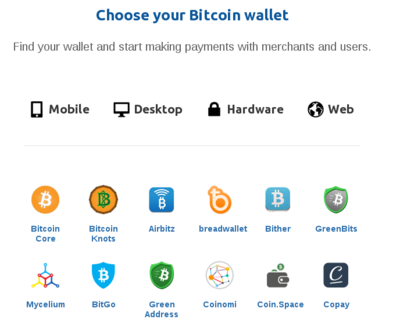
Bitcoin currently has a large number of wallets that can work as programs, mobile applications and even as devices.
Although Bitcoin incorporates encryption in order to achieve anonymity in purchases, it requires that transactions can not be associated with your legal identity. This is not so simple, you can see more information at: https://en.bitcoin.it/wiki/Anonymity. For this guide we will use the wallet that comes in TAILS by default: Electrum [9].
Five steps to create a wallet in TAILS
1) In Applications go to Internet and open Electrum Wallet Bitcoin
2) Follow the process by selecting the option to create a new wallet standard
3) The wallet creation program generates 13 words and suggests you copy them on paper or use a QRT code. You can choose the one you prefer but for the QRT code you will also need a program that reads this type of code.
4) You will be prompted for a password (use a strong one and do not forget it)
5) The program will ask you if it connects itself or if you prefer to do it manually, you can select the option that better suits you.
6) Your wallet has been created. You now have an address to 'receive' deposits and you can make transactions with others by sending them Bitcoins if you know their shipping addresses.
===Adding Bitcoins to your wallet===
There are different ways to to receive bitcoins in your wallet. To buy Bitcoins anonymously you need to find an intermediary organization that trades bitcoins and that will accept an anonymous bank ATM deposit (you'll need to find a bank that offers this service -eg Cite error: Closing </ref> missing for <ref> tag .
Buying
As in other types of electronic transactions, to buy something, you need to find services that accept bitcoins, for example sellers of domains, electronic products, services, medicines, and then you need to know where to send the bitcoins, i.e. a shipping address: https://en.wikipedia.org/wiki/OpenBazaar.
Final notes
Remember that all transactions are public so, to avoid addresses being associated with purchases, you can make deposits of small quantities of bitcoins and transfer equally small amounts.
You should also remember that ATMs have cameras and that effective facial recognition is increasingly widely used.
Finally, there are countries where it is illegal to use Bitcoins [10] .
References
- ↑ ASCII de una moneda del siglo VI a. C. 1/3 de Estátera.
- ↑ https://en.wikipedia.org/wiki/Cryptocurrency
- ↑ https://steemit.com/money/@morpheustitania/onecoin-is-a-scam
- ↑ https://en.wikipedia.org/wiki/DigiCash
- ↑ https://en.wikipedia.org/wiki/Proof-of-work_system
- ↑ http://chimera.labs.oreilly.com/books/1234000001802/ch01.html#_what_is_bitcoin
- ↑ https://en.wikipedia.org/wiki/Blockchain_%28database%29
- ↑ https://bitcoin.org/en/choose-your-wallet
- ↑ https://electrum.org/#home
- ↑ https://en.wikipedia.org/wiki/Legality_of_bitcoin_by_country

